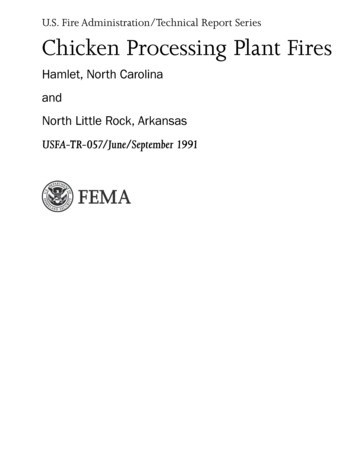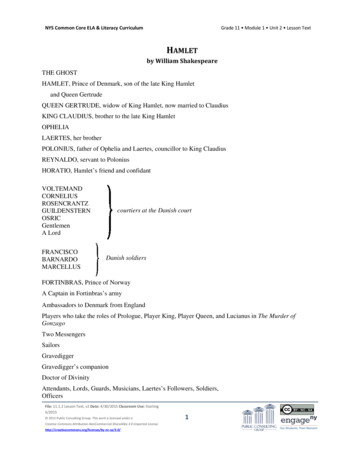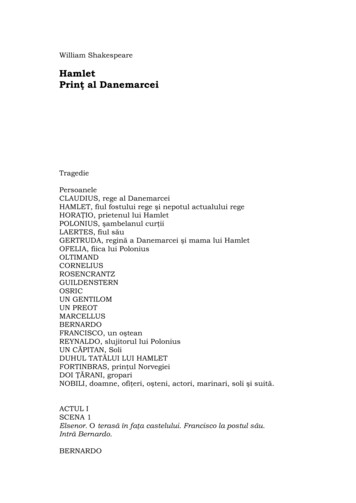
Transcription
U.S. Fire Administration/Technical Report SeriesChicken Processing Plant FiresHamlet, North CarolinaandNorth Little Rock, ArkansasUSFA-TR-057/June/September 1991
U.S. Fire Administration Fire Investigations ProgramThe U.S. Fire Administration develops reports on selected major fires throughout the country.The fires usually involve multiple deaths or a large loss of property. But the primary criterionfor deciding to do a report is whether it will result in significant “lessons learned.” In somecases these lessons bring to light new knowledge about fire--the effect of building construction orcontents, human behavior in fire, etc. In other cases, the lessons are not new but are serious enoughto highlight once again, with yet another fire tragedy report. In some cases, special reports are developed to discuss events, drills, or new technologies which are of interest to the fire service.The reports are sent to fire magazines and are distributed at National and Regional fire meetings. TheInternational Association of Fire Chiefs assists the USFA in disseminating the findings throughout thefire service. On a continuing basis the reports are available on request from the USFA; announcements of their availability are published widely in fire journals and newsletters.This body of work provides detailed information on the nature of the fire problem for policymakerswho must decide on allocations of resources between fire and other pressing problems, and withinthe fire service to improve codes and code enforcement, training, public fire education, buildingtechnology, and other related areas.The Fire Administration, which has no regulatory authority, sends an experienced fire investigatorinto a community after a major incident only after having conferred with the local fire authoritiesto insure that the assistance and presence of the USFA would be supportive and would in no wayinterfere with any review of the incident they are themselves conducting. The intent is not to arriveduring the event or even immediately after, but rather after the dust settles, so that a complete andobjective review of all the important aspects of the incident can be made. Local authorities reviewthe USFA’s report while it is in draft. The USFA investigator or team is available to local authoritiesshould they wish to request technical assistance for their own investigation.This report and its recommendations were developed by USFA staff and by TriData Corporation,Arlington, Virginia, its staff and consultants, who are under contract to assist the USFA in carryingout the Fire Reports Program.The USFA greatly appreciates the cooperation and information received from Hamlet, North CarolinaFire Chief David Fuller and Captain David Knight, State Fire and Rescue Division Deputy CommissionerTimothy L. Bradley and Deputy Director Ray Eastman and Special Agent David H. Campbell of theState Bureau of Investigation. Thanks also go to officials of Tyson Foods, Inc., Shannon Weathers,Mike Edmunds and Mike McAlister.For additional copies of this report write to the U.S. Fire Administration, 16825 South SetonAvenue, Emmitsburg, Maryland 21727. The report is available on the USFA Web site at http://www.usfa.dhs.gov/
Chicken Processing Plant FiresHamlet, North CarolinaandNorth Little Rock, ArkansasInvestigated by: Jack YatesThis is Report 057 of the Major Fires Investigation Project conductedby TriData Corporation under contract EMW-90-C-3338 to the UnitedStates Fire Administration, Federal Emergency Management Agency.Department of Homeland SecurityUnited States Fire AdministrationNational Fire Data Center
U.S. Fire AdministrationMission StatementAs an entity of the Federal EmergencyManagement Agency (FEMA), the missionof the U.S. Fire Administration (USFA) is toreduce life and economic losses due to fireand related emergencies, through leadership, advocacy, coordination, and support. Weserve the Nation independently, in coordination with other Federal agencies, and in partnership with fire protection and emergencyservice communities. With a commitment toexcellence, we provide public education, training, technology, and data initiatives.
TAbLe oF CoNTeNTSOVERVIEW . . . . . . . . . . . . . . . . . . . . . . . . . . . . . . . . . . . . . . . . . . . . . . . . . . . . . . . . . . . . . . . . . . 2SUMMARY OF KEY ISSUES. . . . . . . . . . . . . . . . . . . . . . . . . . . . . . . . . . . . . . . . . . . . . . . . . . . . . . 2THE BUILDING. . . . . . . . . . . . . . . . . . . . . . . . . . . . . . . . . . . . . . . . . . . . . . . . . . . . . . . . . . . . . . . 2THE FIRE. . . . . . . . . . . . . . . . . . . . . . . . . . . . . . . . . . . . . . . . . . . . . . . . . . . . . . . . . . . . . . . . . . . . 3FIRE SUPPRESSION AND EMERGENCY MEDICAL SERVICES (EMS). . . . . . . . . . . . . . . . . . . . . . 5DISASTER PLAN. . . . . . . . . . . . . . . . . . . . . . . . . . . . . . . . . . . . . . . . . . . . . . . . . . . . . . . . . . . . . . 7STRESS MANAGEMENT . . . . . . . . . . . . . . . . . . . . . . . . . . . . . . . . . . . . . . . . . . . . . . . . . . . . . . . . 7CODE ENFORCEMENT HISTORY. . . . . . . . . . . . . . . . . . . . . . . . . . . . . . . . . . . . . . . . . . . . . . . . . 7NORTH LITTLE ROCK, ARKANSAS FIRE. . . . . . . . . . . . . . . . . . . . . . . . . . . . . . . . . . . . . . . . . . . 7FIRE PROTECTION EQUIPMENT AND SAFETY PROGRAMS . . . . . . . . . . . . . . . . . . . . . . . . . . . 8LESSONS LEARNED. . . . . . . . . . . . . . . . . . . . . . . . . . . . . . . . . . . . . . . . . . . . . . . . . . . . . . . . . . . 10Appendix A: Imperial Foods Plant Floor Plan. . . . . . . . . . . . . . . . . . . . . . . . . . . . . . 12Appendix B: Hamlet, North Carolina, Fire Department Incident Report . . . . . 13Appendix C: Imperial Foods Plant Fire Photographs. . . . . . . . . . . . . . . . . . . . . . . 14Appendix D: Tyson Foods Safety Policy, Monthly Fire InspectionsChecklist and Other Fire Safety Program Materials. . . . . . . . . . . . . . . . . . . . 35
Chicken Processing Plant FiresHamlet, North Carolina(September 3, 1991)North Little Rock, Arkansas(June 7, 1991)Local Contacts:Hamlet, North Carolina FireChief David FullerCaptain David KnightHamlet Fire Department302 Champlain StreetP.O. Box 1229Hamlet, North Carolina 28345Deputy Director Ray EastmanSpecial Agent David H. CampbellArson DivisionNorth Carolina State Bureau of InvestigationP.O. Box 29500Raleigh, North Carolina 27626Timothy L. Bradley - Deputy CommissionerFire and Rescue DivisionNorth Carolina Department of InsuranceP.O. Box 26387Raleigh, North Carolina 27611North Little Rock, Arkansas FireShannon Weathers - Fire Safety Coordinator LossControlMike Edmunds - Corporate Safety DirectorMike McAlister - Plant Manager – Prospect FarmsTyson Foods, Inc.P.O. Box 2020Springdale, Arkansas 72765-20201
2U.S. Fire Administration/Technical Report SeriesOThe morning work shift of employees at the Imperial Foods Processing Plant in Hamlet, NorthCarolina, had just begun when a fire occurred, at approximately 8:15 a.m., on September 3, 1991.The rapid spread of heavy smoke throughout the structure ultimately resulted in 25 fatalities and54 people being injured in varying degrees. Of the people who died, 18 were women and sevenwere men.SUMMARY oF KeY ISSUeSIssuesCommentsCasualtiesTwenty-five fatalities and 54 people injured in varying degrees.Building StructurePoultry processing plant of 30,000 square feet with open work areas, sealed concrete slab floor,ceramic tile walls, and ceilings of formica-type finish. Interior kept cool.Origin and CauseThe conveyor to a cooker had hydraulic line repaired which burst when brought up to full pressure.Hydraulic fluid expelled at 800 to 1,500 psi, ignited by heating gas plumes of a cooking vat.Fire SpreadImmediate and very rapid spread of heavy black smoke throughout the building.EvacuationFireball and rapid spread of smoke caused disorderly evacuation attempts. Several exit doorslocked, drove employees to seek refuge in cooler or seek other exits. Rapid build-up of toxic gaseskilled personnel attempting to escape.Detection and AlarmPlant Operations Manager found phone line already inoperable, ran to vehicle and drove to firestation.ResponseRapid response by combination department and people from immediate community includingmedical personnel who ran from nearby hospital. Search and rescue delayed by heavy smoke andheat. Ample mutual aid from neighboring communities, including helicopter transport of victims toregional medical facilities.Code EnforcementDuring the 11-year operation of the plant, no inspection conducted by North Carolina OccupationalSafety and Health Administration.Critical Incident StressDebriefings provided through Pee Dee Council of Government. Many fire service personnelinvolved in incident knew or were related to the victims.A similar type fire occurred at a chicken processing plant in North Little Rock, Arkansas, on June7, 1991, but with no fatalities or injuries. Following the description of the Hamlet fire below,the North Little Rock fire is summarized along with the factors in the different outcomes of thesetwo fires.THe bUILDINGImperial Foods occupied a one-story brick and metal structure that over the years had been used forvarious food product operations. Reportedly, the previous operation had been in dairy products. Assuch, the interior work areas had walls, ceilings, and floors conducive for that type of operation. Thismeant that these three surface areas were of materials that could be washed down. The floor wasa sealed concrete slab, the walls were ceramic tile, and the ceilings were a formica-type finish. Thetotal square footage was approximately 30,000. For the layout of the plant see Appendix A.
USFA-TR-057/June/September 19913Imperial Foods operations did not include the slaughter of poultry. Rather, poultry parts wereshipped to the plant, which prepared and cooked the chicken. The cooked chicken would then bedistributed to various markets for use in restaurants.The plant had a total employment of approximately 200 people, with a normal shift having around90 employees. Preparation of the poultry products included trimming, marinating, cutting, andmixing. The prepared meat would then be cooked, quick-frozen, packed, and prepared for shipping.Storage areas varied from large drive-in coolers to quick-freezing units.The plant layout allowed easy movement of products from one area to another by electrical forkliftpallet movers. The entryways between the various preparation areas were for the most part openwhile some entrances had a curtain of plastic strips to assist in holding refrigerated air in the rooms.The freezers and coolers had standard refrigeration doors.The preparation areas were for the most part cooled or refrigerated in order to prevent food spoilage. Accordingly, door openings were designed in a manner to seal in the structure, with door sealssimilar to those on a refrigerator. This was necessary to assist in maintaining a constant temperaturein work areas.Day to day the contents inside the building did not represent a major fuel load problem. Theonly combustible products were items such as paraffin-coated shipping boxes and wood pallets.Therefore, the probability of having an extensive fire was considered remote.The bulk of the food processing operations was performed in the south three-fourths of the complex. The north one-fourth was predominantly for storage and loading. The main operations areasby virtue of their cooled, open rooms did present a problem in that there were no smoke or heatbarriers between work areas. This meant that in the event of any type of fire, there would be nothingto impede the travel of heat and smoke. Furthermore, the predominance of hard, smooth surfacesmeant there was little available material to absorb heat and smoke.There were exterior personnel doors throughout the structure. These included the main entrance onthe east side; the southeast loading and trash compacting dock; doors from the break room and theequipment room to the outside; and a door from the packing room which led to the north one-fourthof the building complex. However, the locations of some of these exits and their sizes would in allprobability have excluded them from being considered appropriate as part of an evacuation plan.THe FIReThe area identified on the Floor Plan in Appendix A as the processing room is the room where thefire incident occurred. This area is centrally located within the building complex. Any incidentoccurring in this area could adversely affect much of the building operations and personnel.Poultry products that had already gone through the various marinating and mixing procedures weretaken by conveyor to a cooking vat in the processing room, which contained soybean oil. The oilwas maintained by a thermostat control at a constant temperature of 375 degrees Fahrenheit plus orminus 15 degrees Fahrenheit.A maintenance worker who survived the fire indicated that the hydraulic line that drove the conveyorhad developed a leak. The hydraulic line was turned off and drained of fluid. Then the maintenanceworker disconnected the leaking line and replaced it with a factory prepared line.
4U.S. Fire Administration/Technical Report SeriesThe factory prepared line, however, was found to be too long and would have dragged on the floor,possibly causing people working in the area to trip. So the maintenance worker reportedly asked forand gained permission to cut the factory prepared hydraulic line to an appropriate length, replacedthe end connector with their own connector, and put the line back in-place. This line has beendescribed as a 3/4-inch flex line rated to carry 3,000 psi. Information from plant personnel indicated normal pressure was kept at approximately 800 psi, but it would at times fluctuate as high as1,200 to 1,500 psi.The hydraulic line was brought back to operating pressure. Shortly afterward it separated at therepaired connector point. The connector was some four to six feet above floor level with hydraulicfluid being expelled at a pressure of 800 to 1,500 psi. It obviously began to splatter off the concretefloor. Droplets were bouncing back onto the gas heating plumbs for the cooking vat, which turnedthem into vapor. The vapors then were going directly into the flame. The vapors had a much lowerflashpoint than the liquid hydraulic fluid and therefore rapidly ignited.In sum, the pressurization of the hydraulic fluid combined with the heat was causing an atomizingof the fuel which in all probability caused an immediate fireball in and around the failed hydraulicline and the heating plumbs.The ignition of the fuel caused an immediate and very rapid spreading of heavy black smoke throughout the building. Seven workers were trapped between the area of origin and any escapable routes.Measurement of the system during the investigation after the fire indicated 50 to 55 gallons ofhydraulic fluid fueled the fire before electrical failure shut the system down. (Investigators statedthat if the hydraulic system was fully charged and its reservoirs filled to capacity it would have held110 gallons of 32 weight ISO hydraulic fluid.)In addition to the hydraulic fluid, the fire reached a natural gas regulator that in turn failed andcaused an induction of natural gas to the fire increasing the intensity and buildup of toxic gases.The fires in both this incident and the North Little Rock incident were centered around the cookingvat areas and expanded outward from there. In both incidents, the vats ultimately did ignite in latter stages of the fire, but in the initial stages the vats did not ignite. The vats in both locations havea hood-mounted system over them with built-in CO2 heads. But after considerable burning withsecondary falldown, the oil in both vats did eventually ignite and burn.Witness reports indicate much of the plant was enveloped in under two minutes. Workers throughout the plant found their visibility eliminated and oxygen quickly consumed. Hydrocarbon-chargedsmoke, particularly as heavy as this, is extremely debilitating to the human body and can disable aperson with one or two breaths. This was confirmed as autopsies conducted on all of the fatalitiesfound that virtually all died of smoke inhalation as opposed to direct flame injury.Survivors indicate there was no real organization in the plant’s evacuation, and this was confirmedby the locations of the bodies. Several employees in the central part of the structure moved to thetrash compactor/loading dock area near the southeast corner of the building. It was here they foundone of the personnel doors to the outside locked. A trailer was backed into the loading dock cuttingoff all exiting through this area. One woman became trapped between the compactor seal and thebuilding wall while trying to squeeze through an opening. A number of remaining people in thisarea went into a large cooler adjacent to the loading dock, but failed to pull the sealed door shut thusallowing smoke infiltration into the cooler. The cooler had the largest single fatality count area with12 deceased people being removed from this room along with five injured people.
USFA-TR-057/June/September 19915The second largest fatality area were the seven trapped in the processing room between the fire andany escape route. Three additional bodies were found in the trim room area, one of whom was aroute salesman who had been filling food machines in the break room. The exterior personnel doorin the break room was the other door locked from the outside.The people who died in this tragic fire were as follows:NameJosephine BarringtonPeggy AndersonMary Lillian WallPhilip R. DawkinsMinnie Mae ThompsonJanice Marie Wall LynchElizabeth Ann BellamyCynthia S. WallJosie M. CoulterBertha JarrellJohn Robert GagnonRose Marie Gibson PeeleMary Alice Arnold QuickFred Barrington, Jr.Martha A. RatliffGail V. CampbellRosie Ann ChambersMichael MorrisonRose Lynette WilkinsBrenda Gail KellyDavid Michael AlbrightMargaret BanksDonald Bruce RichJeffrey Antonia WebbCynthia Marie etHamletBennettsville, e, SCHamletRockinghamHamletHamletEllerbeHamletLaurel IRe SUPPReSSIoN AND eMeRGeNCY MeDICAL SeRVICeS (eMS)Upon discovery of the fire, the operations manager of the plant attempted to call the alarm to the firedepartment, but found that phone lines were already inoperable. (Imperial Foods was not equippedwith pull-station alarms, nor does the town have 9-1-1.) He then ran to this vehicle parked outsideand drove some three to five blocks to the fire station.The initial equipment left the station at 8:24 a.m., and was on the scene three minutes later. Fire ChiefDavid Fuller indicated the first smoke he observed was grayish-yellow in color. He stated that Hamlethas two paid firefighters on-duty at all times with 28 volunteers. Of the 28 volunteers, 22 respondedto the scene. (See Appendix B for Fire Department Incident Report.) He also stated there is a county
6U.S. Fire Administration/Technical Report Seriesmutual aid agreement and that Captain Calvin White immediately called for the Rockingham FireDepartment to stand in at the station. Lieutenant David Knight indicated that upon their arrival onthe scene they immediately encountered three dead-on-arrivals and 15 to 18 casualties. Their firstactions were to administer first-aid and attempt victim rescue. Once they had backup companies onthe scene, the fire was attacked. Extremely heavy volumes of smoke prevented them from pinpointing the seat of the fire in the early stages. AFFF foam was used to extinguish the vats which eventuallycaught fire. Upon seeing the magnitude of the incident, additional mutual aid assistance was calledin, including the East Rockingham, Cordova, and North Side Fire Departments.In addition, two EMS units were initially brought in by volunteers with a third unit added later.Shortly afterwards, a call was made to the County Sheriff’s Office to call all available EMS units tothe scene. These consisted of two from Rockingham, three from the county, one from Cordova, onefrom Ellerbe, and one from Hoffman. Also, there were helicopters from Winston-Salem, Chapel Hill,Duke, and Charlotte which took patients from the hospital in Hamlet to the various burn units. Thehelicopters did not operate from the scene.Chief Fuller stated that the City of Hamlet did not have its own inspectors and relied on one of thecounty’s three inspectors. The county has an inspector for building codes, another for electrical andanother for plumbing. These inspectors are primarily for new construction or remodeling. Hamletconstruction codes reference the Southern Building Code. Chief Fuller stated the local code requires“periodic” inspections but do not specify a schedule or frequency.The original building at Imperial Foods was built in the early 1900’s. Today no one appears to know whatcodes existed when the plant was first built. Chief Fuller indicated there had been several fires in the plantover the years, some before Imperial Foods took over the facility. Imperial was operating the plant in 1983when one of the previous fires occurred after which a CO2 system and hood over the cooker was installed.Subsequently, they were required to install a CO2 system by the county inspector.Firefighters immediately began a search and rescue operation but were met by considerable heat andfire coming from the processing area. They had to withdraw and reposition to initiate their attack onthe fire through the equipment room which was next to the processing room. The fire was broughtunder control at approximately 10:00 a.m.Search and rescue efforts continued during the fire suppression with injured people and fatalitiesbeing located from the first entry at approximately 8:45 a.m., with the final victim being locatedshortly after 12:00 noon. Concern for the integrity of the roof structure prevented earlier discoveryof victims in the processing room area.Treatment of casualties was being carried out during the entire incident until all were removed fromthe fireground. Word of the incident’s severity spread through the community quickly, and virtuallyeveryone involved with medical care in the area responded to the plant site. The Hamlet Hospital isapproximately six blocks from Imperial Foods.Chief Fuller was asked to evaluate the handling of the incident with reference to fire suppression,rescue, and EMS to which he indicated he felt there were more than adequate numbers of personneland equipment given the layout of the incident site. As it was, he stated there were minor problemsof some EMS equipment running over charged hoselines. There was some problem later in the firesuppression with air for the self-contained breathing apparatus (SCBA) supply because tanks werebeing used to assist injured victims, as well as supplying fire personnel. Chief Fuller stated the entireincident centered around one problem – lack of enforcement of existing codes.
USFA-TR-057/June/September 19917DISASTeR PLANHamlet does have a disaster plan in-place which coincides with the county plan. This fire occurredso rapidly and was so serious that all of the resources planned for were immediately brought to thescene. Under the plan the mayor is in charge of media relations and this became an enormous task,which was handled well even though much greater demands were being made upon them than hadever been planned for.STReSS MANAGeMeNTThe Hamlet Fire Department personnel suffered severe stress and emotional reactions because thecommunity was small and the firefighters knew many of the victims. A critical incident stress debriefing was arranged through the Pee Dee Council of Government (Region H). Five counselors werebrought in and 50 to 60 people attended the counseling sessions.CoDe eNFoRCeMeNT HISToRYMuch discussion has taken place about the lack of inspections conducted by the North CarolinaDepartment of Occupational Safety and Health Administration (OSHA) at the Imperial Food operations. In fact, during the 11-year operation of this plant, North Carolina OSHA had never inspectedthe facility.NoRTH LITTLe RoCK, ARKANSAS FIReDuring the course of the investigation of the Hamlet, North Carolina, fire, information was receivedthat another company had experienced a similar fire at a plant in Arkansas. Further inquiries revealedthat indeed a similar fire had occurred at a Tyson Foods, Inc., facility in North Little Rock, Arkansas,on June 7, 1991, but with dramatically different results.Tyson Foods, Inc., is the largest producer of poultry products worldwide. Corporate officials stronglybelieve that their safety program is what made the difference between their fire and the Hamlet,North Carolina, fire. This company has over the years enacted many proactive fire safety programs.Their operation and plant type in North Little Rock is similar in product production but larger insize than the Hamlet plant. The fire that occurred on June 7, 1991, was in the same plant area asthe Hamlet fire in that it broke out in the hydraulic system of their cooker (also made by Stein andAssociates, as was the one in Hamlet).Unlike the Hamlet fire though, the hydraulic failure occurred within fixed plumbing. A flange typenut over time had the threads stripped as a result of vibration and when the threads failed, hydraulicfluid was expelled at approximately 800 psi. As with the Hamlet fire, the fluid was immediately inan atomization state. This was occurring within the gas heating plume areas and fire ignited. Theresulting fire created a heavy black smoke and, as seen in Hamlet, virtually coated everything itspread to.The Tyson plant, however, had in-place numerous safety factors that averted disaster. They enforcedlife safety codes to include not only plant design but practiced emergency drills.Tyson Foods has a fire safety director who has implemented evacuation programs throughout thecompany’s entire operations. These programs involved both hourly personnel and management staffin safety committees. They have formed fire brigades and have a program called the Incipient Fire
8U.S. Fire Administration/Technical Report SeriesForce, which involves all personnel and has a common goal to educate and train all employees in lossprevention and to take proper action should an emergency occur.On June 7, there were 115 people working at the North Little Rock plant with some 12 to 14 peoplein the packaging area above the production room where the fire occurred. The plant design wassuch that the minimal number of people needed to operate the cookers were the only ones in theactual ignition area. The cookers were in rooms with 2-hour fire rated walls and ceilings, and thecookers were fed by conveyors through small openings. When the worker on the cooker that igniteddiscovered the fire, he first reached for an extinguisher but immediately realized it was spreadingtoo fast and sounded the alarm.Within three minutes, everyone was out of the plant and supervisors immediately identified allemployees by name to make certain all were accounted for. No injuries of any kind occurred. Uponfire equipment arriving at the scene, fire brigade members, wearing hazardous materials protectiveclothing and SCBA equipment, met the firefighters and guided them through the plant to the seat ofthe fire.The initial response came from Station 4 of the North Little Rock Fire Department. Backup camefrom the North Little Rock central station and also from the Little Rock Fire Department.They were on the scene for approximately 9-1/2 hours. There were a total of 23 fire service personnel who responded with a total of six engines, one piece of aerial equipment, and three other typesof vehicles.As with the Hamlet fire, heavy, black smoke quickly permeated the entire facility. The firewalls surrounding the cookers no doubt gave the people evacuating more lead time – this was part of theirpre-fire planning in that the cookers were designed to be isolated as much as possible from theremainder of the plant. In addition, Tyson allows absolutely no combustible materials such as woodpallets or paraffin-coated cardboard boxes inside the cooker rooms.These types of operations are viewed as a wet industry for the most part. Accordingly, much of thefacilities are not sprinklered. Tyson’s safety personnel did not feel that sprinklers would have contributed to the prevention of loss of life due to the nature of the hydraulic-fluid-fueled fire. They do,however, have sprinkler protection in all areas that are non-wet operations.Damages to the structure amounted to approximately 8 million dollars and the plant was down for13 weeks. The additional loss in production, wages, cleanup, etc., was approximately 4 million dollars making the total loss approximately 12 million dollars. But upon getting back to production, theremodeling of the plant eliminated certain inefficiencies and implemented numerous safety featuresbeyond what they already had. The plant currently has 215 employees, which is slightly less than thework force at the time of the fire.FIRe PRoTeCTIoN eQUIPMeNT AND SAFeTY PRoGRAMSThe plant now has shut off valves designed for each cooker. These valves have four functions in thatthey are calibrated to the hydraulic fluid velocity or flow of what each cooker needs or uses. Shouldthere be 1) a sudden free flow of fluid; 2) a drop in line pressure; or 3) an electrical failure, the valvewill shut the hydraulics down. It is also tied into the CO2 system. In addition, they have mandatedthat if a system is installed by an outside manufacturer, then training must come from the manufacturer on maintenance of the item.
USFA-TR-057/June/September 19919In addition to the shut off va
North Carolina Department of Insurance P.O. Box 26387 Raleigh, North Carolina 27611 North Little Rock, Arkansas Fire . Control Mike Edmunds - Corporate Safety Director Mike McAlister - Plant Manager - Prospect Farms Tyson Foods, Inc. P.O. Box 2020 Springdale, Arkansas 72765-2020 . 2 U.S. Fire Administration/Technical Report Series .











